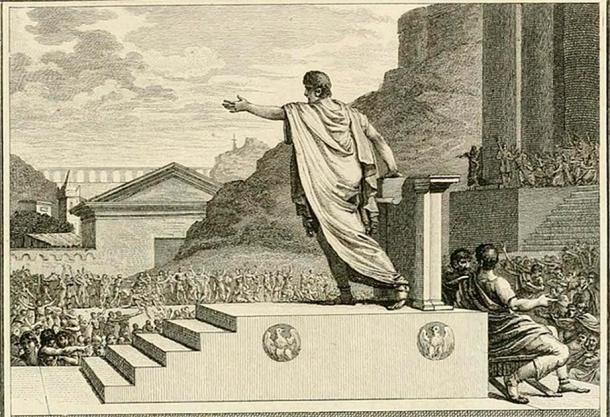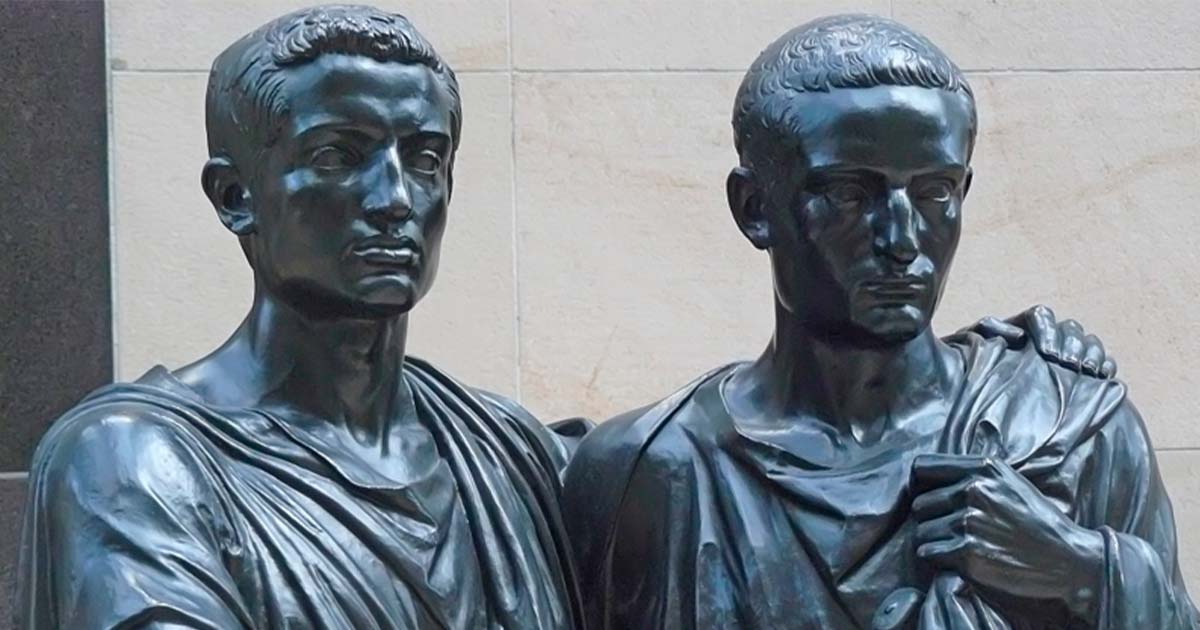The Gracchi: How Two Brothers Altered the Course of Roman Politics
The Late Republic was in ruins. Civil war was common. Violence broke out between political factions. Bloody slave revolts erupted. As Rome’s old republican institutions imploded, the Republic began to be dominated by competing warlords. Enter the Gracchi brothers.
Who Were the Gracchi?
The Gracchi brothers, Tiberius and Gaius, were the grandsons of the famous Scipio Africanus, who had defeated Hannibal in the Second Punic War, and sons of Tiberius Sempronius Gracchus, a very successful politician and general. All were part of the Aemilian clan, which dominated Rome’s politics.
By the time the Romans had conquered the Mediterranean, it became increasingly unstable and fragmented. The Republic began to splinter into disgruntled segments of society, each with their own set of grievances. Veterans complained that they weren’t given enough benefits. Poor Romans were upset. The Italian allies of Rome demanded full citizenship. Traditional aristocratic families complained about the dominance of Rome’s military in public affairs. The conquered peoples, who were forced into plantation labor for rich Romans, were outraged.
- An Elite Class That Ruled Over the 99%. Sound Familiar? It All Began with the Patricians of Rome
- Was Emperor Tiberius Simply Destined to Rule?
The Gracchi were unusual, because they were not members of any of these aggrieved groups. They were the beneficiaries of Rome’s imperialism. But despite their privilege, the two brothers were concerned about a growing crisis in the Republic. Tiberius walked the Etruria, and he saw the problem. Rome’s traditional small-time family farms, which had been owned by Rome’s citizens, were now a grotesque collection of massive plantation estates, worked by hordes of foreign-born slaves and owned by rich oligarchs.

Young Gracchi brothers and their mother Cornelia, by Umberto Ruini, 1892. (Archivio fotografico del Museo Civico di Modena/CC BY-SA 3.0)
Tiberius realized the gravity of the crisis. The Republic had been founded by citizen-farmers, who owned property. But now, many Roman veterans were left homeless and jobless. Tiberius began to give speeches, and demanding change. “The Romans are called the masters of the world,” he said, “but they do not possess a single clod of dirt which they can truly call their own.”
Tiberius, the Tribune
Tiberius was elected as Tribune of the Plebs. He had the power to propose legislation directly to voting assemblies. This enabled him to impose limits on land ownership. He gave land to poor citizens, turning homeless people into productive farmers.
The Gracchi attempted to turn back the clock to the old days of Rome’s Republic, before the emergence of large slave plantations. In the old days, the Romans lived on small family farms, owned by honorable citizen-soldiers like the legendary Cincinnatus.
Tiberius’ proposals were not radical. There was already an official commission to oversee land redistribution. But he did something radical: he circumvented the Senate by proposing laws directly to the people. To the Senate, it was a dangerous way of undermining Rome’s elite class.

Statue of Tiberius. (Egisto Sani/flickr)
With much difficulty, the Gracchi managed to enact reforms. A land commission was established, but it was obstructed by the Senate. The Gracchi’s reforms broke many Roman traditions, but they were massively popular. Tiberius ran for an unprecedented second-term as Tribune in 132 BC to continue his reforms. The Senate took things to the next level, and literally murdered Tiberius. Over the next century, political violence became the norm in the dying Republic.
Gaius’ Reforms
Tiberius’ younger brother, Gaius, rose to power in 123 BC. He decided to continue his elder brother’s legacy. He proposed that soldier uniforms be provided by Rome’s government. He called for new roads and colonies. He demanded that juries represent the poorer classes. He called for subsidized grain for poor citizens, an early example of welfare. He demanded that Rome’s Latin allies receive full citizenship.
The centerpiece of his reforms was to distribute public land to poor citizens. Gaius’ reforms were even more expansive than those of his brother. He appealed to the various disgruntled groups of Roman society, and turned the balance of power in the people’s favor. He was extremely popular, and re-elected for Tribune in 122 BC. The Senate was enraged, but because of their disgrace following Tiberius’ murder, they were reluctant to act against Gaius. Instead, they backed another Tribune, who proposed even more radical reforms. Opposition to Gaius grew. The Senate passed emergency laws, which were used for political persecutions. Gaius was chased out of Rome, and died soon after.

Painting of the “Death of Gaius Gracchi”. (Public Domain)
The Gracchi Legacy
The Republic was beginning to crumble. It might have survived if the Gracchi reforms were adopted, but the ruling class refused to listen. The Gracchi legacy continues to be hotly debated today. Were they selfless reformers, who could have saved the Republic? Were they merely ambitious aristocrats who exploited populism for personal purposes? Perhaps it was a mixture of the two. Regardless of their motives, the Gracchi changed Rome forever. Reform efforts were stamped out, leaving the social unrest to fester dangerously. This led to even more extreme acts of political violence. The Latin allies revolted in what became the Social War.

Gaius Gracchi, tribune of the people, presiding over the Plebeian Council. (Public Domain)
Rome’s vast slave population revolted three times, in the three Servile Wars. The Gracchi were also the beginning of a long and bitter power struggle between the Senate and the Tribunes. The institutions of the Republic were permanently undermined, and violence became increasingly accepted as a means of social change. Factionalism grew worse within Rome. The Optimates were aristocratic elites who clung to Roman conditions. The Populares championed the causes of the commoners. The two factions were not official organizations or parties, but rather loose coalitions. The Optimates tried to portray themselves as defenders and restorers of the old Republic. The Populares presented themselves as the selfless servants of the people’s will. But both groups were self-interested and ambitious.
- The Strict Rules Dividing Ancient Roman Social Classes
- More Than a Founder, Marcus Furius Camillus Was an Exemplar of Roman Virtue
Jugurtha’s War
Numidia was an enemy of Rome. After the Punic Wars, Rome turned its wrath against this hostile kingdom. When Numidia broke into a civil war, the Romans intervened. Jugurtha rejected Rome’s settlement, and led a military campaign against Roman troops in the region. The commoners of Rome, worried about Rome’s grain supply, demanded war against Numidia. The Populares supported war, but the Optimates did not.

Framed miniature of King Jugurtha paraded through Rome as a prisoner. (Public Domain)
Forced by popular opinion to wage war, the Romans went to fight. Rome’s foreign entanglements only served to escalate the internal tensions of the Republic. One general, named Gaius Marius, led the war against Jugurtha. Marius became the most powerful Roman of his era. He became consul for an unprecedented seven times. He became the first of a series of warlords who would dominate the Late Republic.
Continue the story of why Gaius Marius is considered a savior of the Roman Republic here.
Top image: The Gracchi, by Jean-Baptiste Claude Eugène Guillaume (19th century). Musée d’Orsay, Paris. Source: Mary Harrsch/ CC BY NC-SA 2.0
By Ben Shehadi
References
Aldrete, Gregory S., Ph.D. The Rise of Rome (Lecture 16: The Gracchi Attempt Reform). University of Wisconsin – Green Bay. Available at: https:// youtu.be/aTwjsIhcQmI?feature=shared

















